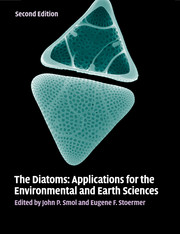Book contents
- Frontmatter
- Contents
- List of contributors
- Preface
- Part I Introduction
- Part II Diatoms as indicators of environmental change in flowing waters and lakes
- Part III Diatoms as indicators in Arctic, Antarctic, and alpine lacustrine environments
- Part IV Diatoms as indicators in marine and estuarine environments
- 15 Diatoms and environmental change in large brackish-water ecosystems
- 16 Applied diatom studies in estuaries and shallow coastal environments
- 17 Estuarine paleoenvironmental reconstructions using diatoms
- 18 Diatoms on coral reefs and in tropical marine lakes
- 19 Diatoms as indicators of former sea levels, earthquakes, tsunamis, and hurricanes
- 20 Marine diatoms as indicators of modern changes in oceanographic conditions
- 21 Holocene marine diatom records of environmental change
- 22 Diatoms as indicators of paleoceanographic events
- 23 Reconsidering the meaning of biogenic silica accumulation rates in the glacial Southern Ocean
- Part V Other applications
- Part VI Conclusions
- Glossary, acronyms, and abbreviations
- Index
- References
18 - Diatoms on coral reefs and in tropical marine lakes
from Part IV - Diatoms as indicators in marine and estuarine environments
Published online by Cambridge University Press: 05 June 2012
- Frontmatter
- Contents
- List of contributors
- Preface
- Part I Introduction
- Part II Diatoms as indicators of environmental change in flowing waters and lakes
- Part III Diatoms as indicators in Arctic, Antarctic, and alpine lacustrine environments
- Part IV Diatoms as indicators in marine and estuarine environments
- 15 Diatoms and environmental change in large brackish-water ecosystems
- 16 Applied diatom studies in estuaries and shallow coastal environments
- 17 Estuarine paleoenvironmental reconstructions using diatoms
- 18 Diatoms on coral reefs and in tropical marine lakes
- 19 Diatoms as indicators of former sea levels, earthquakes, tsunamis, and hurricanes
- 20 Marine diatoms as indicators of modern changes in oceanographic conditions
- 21 Holocene marine diatom records of environmental change
- 22 Diatoms as indicators of paleoceanographic events
- 23 Reconsidering the meaning of biogenic silica accumulation rates in the glacial Southern Ocean
- Part V Other applications
- Part VI Conclusions
- Glossary, acronyms, and abbreviations
- Index
- References
Summary
Coral reef communities as diatom habitats
Coral reefs, well known for their tremendous biodiversity and beauty (Veron, 2000; Spalding et al., 2001), are the most complex ecosystems in the sea, and are often compared to rainforests, both because of the large numbers of organisms (estimates in both cases based on larger organisms and extrapolated wildly to small animals and microorganisms!) and because corals, like rainforest trees, create the structure and habitat for the wealth of other organisms. Coral reefs are formed by a highly successful yet environmentally sensitive symbiotic association between animals (cnidarians; scleractinian corals) and protists (dinoflagellate algae; zooxanthellae in the genus Symbiodinium). The term coral is generally used to denote the holobiont, i.e. both partners in the symbiosis. On a healthy coral reef, macroalgae are generally sparse and coral cover is high, but the balance can be tipped to communities dominated by fleshy algae by nutrient inputs that promote algal growth in the otherwise oligotrophic waters, or by reduction of normally high grazing pressure (Littler & Littler, 1984).
Coral reefs are vital resources for millions of humans in tropical, especially developing countries, who depend on them for fisheries (Cesar, 2000; Sadovy, 2005; Vincent, 2006), tourism income (Brander et al., 2007), storm protection (UNEP-WCMC, 2006), and sometimes structural materials (Berg et al., 1998; Mallik, 1999). Biodiversity of coral reefs is also recognized for its pharmacological potential (Adey, 2000).
- Type
- Chapter
- Information
- The DiatomsApplications for the Environmental and Earth Sciences, pp. 346 - 356Publisher: Cambridge University PressPrint publication year: 2010
References
- 8
- Cited by



